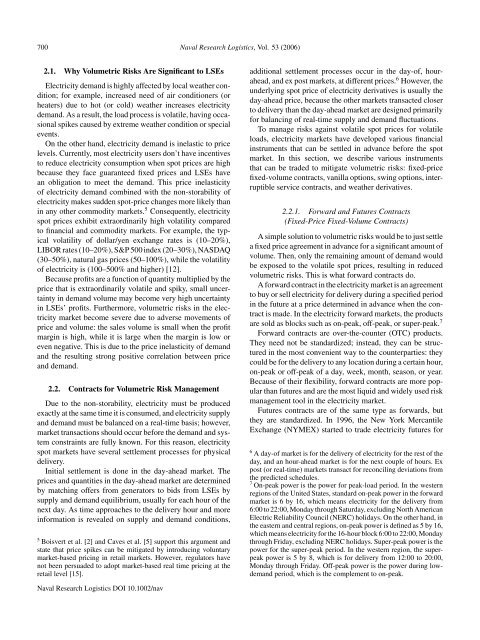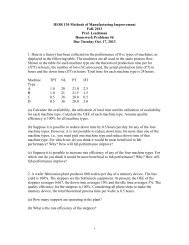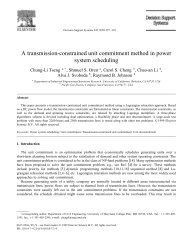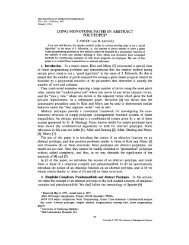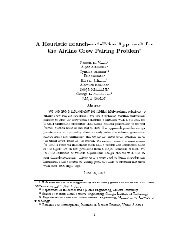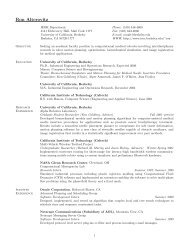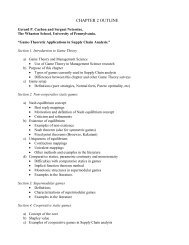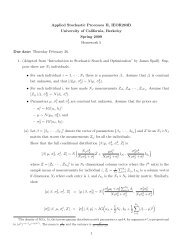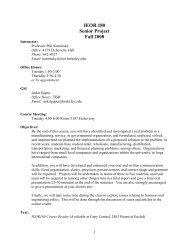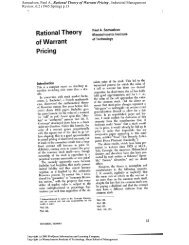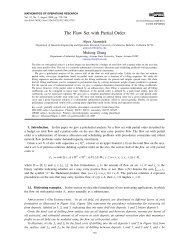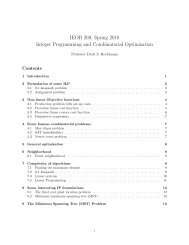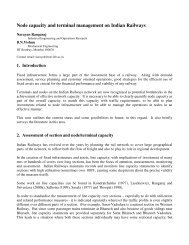Hedging Quantity Risks with Standard Power Options - UC Berkeley ...
Hedging Quantity Risks with Standard Power Options - UC Berkeley ...
Hedging Quantity Risks with Standard Power Options - UC Berkeley ...
You also want an ePaper? Increase the reach of your titles
YUMPU automatically turns print PDFs into web optimized ePapers that Google loves.
700 Naval Research Logistics, Vol. 53 (2006)<br />
2.1. Why Volumetric <strong>Risks</strong> Are Significant to LSEs<br />
Electricity demand is highly affected by local weather condition;<br />
for example, increased need of air conditioners (or<br />
heaters) due to hot (or cold) weather increases electricity<br />
demand. As a result, the load process is volatile, having occasional<br />
spikes caused by extreme weather condition or special<br />
events.<br />
On the other hand, electricity demand is inelastic to price<br />
levels. Currently, most electricity users don’t have incentives<br />
to reduce electricity consumption when spot prices are high<br />
because they face guaranteed fixed prices and LSEs have<br />
an obligation to meet the demand. This price inelasticity<br />
of electricity demand combined <strong>with</strong> the non-storability of<br />
electricity makes sudden spot-price changes more likely than<br />
in any other commodity markets. 5 Consequently, electricity<br />
spot prices exhibit extraordinarily high volatility compared<br />
to financial and commodity markets. For example, the typical<br />
volatility of dollar/yen exchange rates is (10–20%),<br />
LIBOR rates (10–20%), S&P 500 index (20–30%), NASDAQ<br />
(30–50%), natural gas prices (50–100%), while the volatility<br />
of electricity is (100–500% and higher) [12].<br />
Because profits are a function of quantity multiplied by the<br />
price that is extraordinarily volatile and spiky, small uncertainty<br />
in demand volume may become very high uncertainty<br />
in LSEs’ profits. Furthermore, volumetric risks in the electricity<br />
market become severe due to adverse movements of<br />
price and volume: the sales volume is small when the profit<br />
margin is high, while it is large when the margin is low or<br />
even negative. This is due to the price inelasticity of demand<br />
and the resulting strong positive correlation between price<br />
and demand.<br />
2.2. Contracts for Volumetric Risk Management<br />
Due to the non-storability, electricity must be produced<br />
exactly at the same time it is consumed, and electricity supply<br />
and demand must be balanced on a real-time basis; however,<br />
market transactions should occur before the demand and system<br />
constraints are fully known. For this reason, electricity<br />
spot markets have several settlement processes for physical<br />
delivery.<br />
Initial settlement is done in the day-ahead market. The<br />
prices and quantities in the day-ahead market are determined<br />
by matching offers from generators to bids from LSEs by<br />
supply and demand equilibrium, usually for each hour of the<br />
next day. As time approaches to the delivery hour and more<br />
information is revealed on supply and demand conditions,<br />
5 Boisvert et al. [2] and Caves et al. [5] support this argument and<br />
state that price spikes can be mitigated by introducing voluntary<br />
market-based pricing in retail markets. However, regulators have<br />
not been persuaded to adopt market-based real time pricing at the<br />
retail level [15].<br />
additional settlement processes occur in the day-of, hourahead,<br />
and ex post markets, at different prices. 6 However, the<br />
underlying spot price of electricity derivatives is usually the<br />
day-ahead price, because the other markets transacted closer<br />
to delivery than the day-ahead market are designed primarily<br />
for balancing of real-time supply and demand fluctuations.<br />
To manage risks against volatile spot prices for volatile<br />
loads, electricity markets have developed various financial<br />
instruments that can be settled in advance before the spot<br />
market. In this section, we describe various instruments<br />
that can be traded to mitigate volumetric risks: fixed-price<br />
fixed-volume contracts, vanilla options, swing options, interruptible<br />
service contracts, and weather derivatives.<br />
2.2.1. Forward and Futures Contracts<br />
(Fixed-Price Fixed-Volume Contracts)<br />
A simple solution to volumetric risks would be to just settle<br />
a fixed price agreement in advance for a significant amount of<br />
volume. Then, only the remaining amount of demand would<br />
be exposed to the volatile spot prices, resulting in reduced<br />
volumetric risks. This is what forward contracts do.<br />
A forward contract in the electricity market is an agreement<br />
to buy or sell electricity for delivery during a specified period<br />
in the future at a price determined in advance when the contract<br />
is made. In the electricity forward markets, the products<br />
are sold as blocks such as on-peak, off-peak, or super-peak. 7<br />
Forward contracts are over-the-counter (OTC) products.<br />
They need not be standardized; instead, they can be structured<br />
in the most convenient way to the counterparties: they<br />
could be for the delivery to any location during a certain hour,<br />
on-peak or off-peak of a day, week, month, season, or year.<br />
Because of their flexibility, forward contracts are more popular<br />
than futures and are the most liquid and widely used risk<br />
management tool in the electricity market.<br />
Futures contracts are of the same type as forwards, but<br />
they are standardized. In 1996, the New York Mercantile<br />
Exchange (NYMEX) started to trade electricity futures for<br />
6 A day-of market is for the delivery of electricity for the rest of the<br />
day, and an hour-ahead market is for the next couple of hours. Ex<br />
post (or real-time) markets transact for reconciling deviations from<br />
the predicted schedules.<br />
7 On-peak power is the power for peak-load period. In the western<br />
regions of the United States, standard on-peak power in the forward<br />
market is 6 by 16, which means electricity for the delivery from<br />
6:00 to 22:00, Monday through Saturday, excluding North American<br />
Electric Reliability Council (NERC) holidays. On the other hand, in<br />
the eastern and central regions, on-peak power is defined as 5 by 16,<br />
which means electricity for the 16-hour block 6:00 to 22:00, Monday<br />
through Friday, excluding NERC holidays. Super-peak power is the<br />
power for the super-peak period. In the western region, the superpeak<br />
power is 5 by 8, which is for delivery from 12:00 to 20:00,<br />
Monday through Friday. Off-peak power is the power during lowdemand<br />
period, which is the complement to on-peak.<br />
Naval Research Logistics DOI 10.1002/nav


